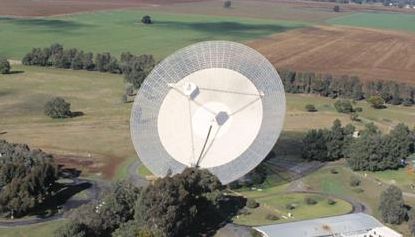Parkes 64 metre radio telescope
The Parkes 64 metre radio telescope is a parabolic dish near the town of Parkes in central New South Wales, Australia. The dish was commissioned in the early 1960s and has been in more or less continuous operation since then for pure research.

Credit: Stuart Duff, CSIRO (used with permission)
The dish is mainly used at cm wavelengths, although can be used at frequencies between 80 MHz and 22 GHz. Famous for its role in the discovery of the quasar, the dish was also important in transmitting the video signal from the original moon landing, for its discovery of ~1000 radio pulsars and some of the most complete neutral hydrogen surveys of the Southern skies, such as the HIPASS survey. The Parkes antenna is also an important part of the Australian VLBI network.
Study Astronomy Online at Swinburne University
All material is © Swinburne University of Technology except where indicated.

